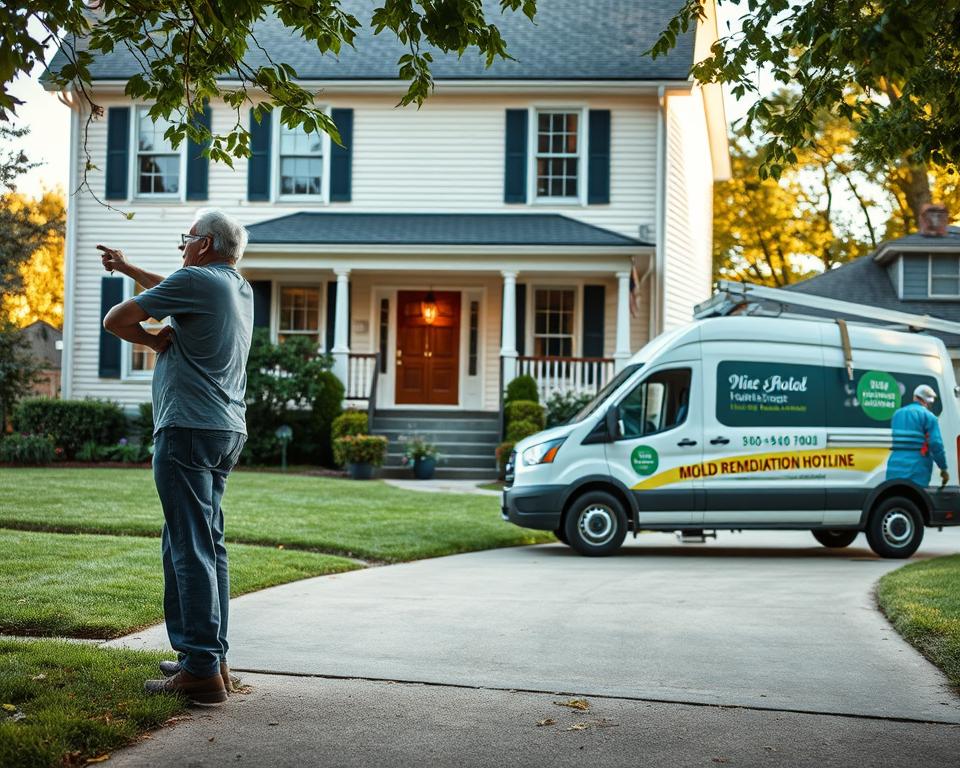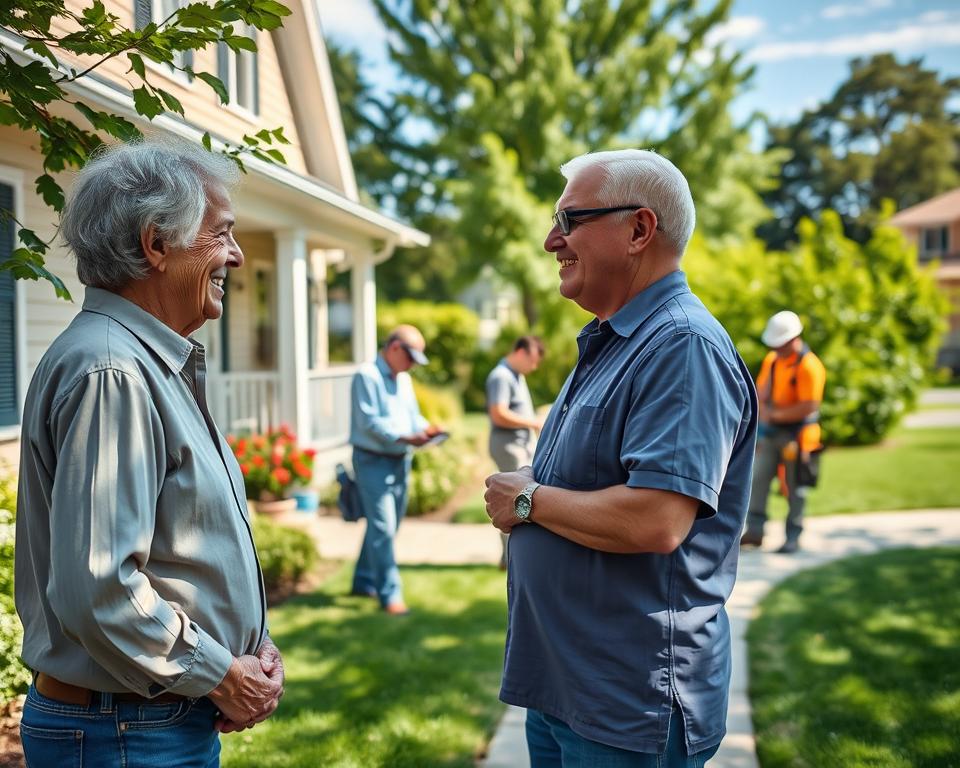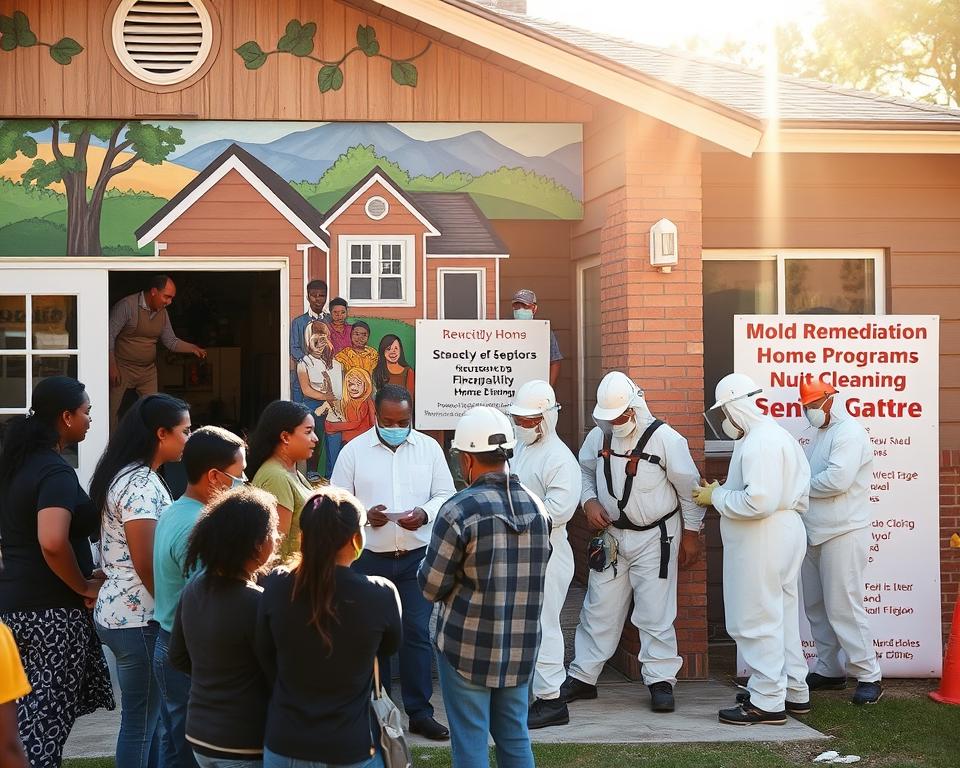Many older homeowners face a silent threat lurking in their living spaces: mold. While addressing it is critical for health, the real challenge lies in navigating affordable solutions tailored to fixed incomes. This guide explores practical strategies to manage remediation costs without compromising safety.
Financial assistance for household improvements often includes government-backed grants or specialized loans. However, not all options work equally for retirees. For example, RenoFi provides renovation loans based on a property’s future value rather than traditional grants. This distinction matters for those planning long-term upgrades.
Balancing limited resources with essential home repairs requires careful planning. Professional services ensure thorough mold removal, but upfront expenses can feel overwhelming. Exploring flexible programs designed for older adults helps bridge this gap, offering pathways to safer living environments.
Key Takeaways
- Safe mold removal is vital for maintaining health in older households.
- Financing options include grants, loans, and specialized renovation programs.
- RenoFi offers loans tied to a home’s projected post-repair value.
- Fixed-income retirees need tailored solutions for costly repairs.
- Professional remediation ensures lasting results and air quality improvements.
Understanding Mold Cleanup Financing for Seniors
Aging properties frequently conceal environmental threats requiring attention. Addressing household contaminants demands solutions that respect fixed budgets while ensuring lasting results. Specialized assistance programs bridge this gap by offering structured pathways to safer living conditions.
Why Professional Removal Matters
Thorough elimination of harmful growths preserves both respiratory health and building stability. Half-hearted DIY attempts often leave spores behind, creating recurring issues. “Proper remediation stops damage at the source,” notes a HUD housing specialist report, “protecting investments and well-being simultaneously.”
Funding Solutions for Safer Living Spaces
Government-backed initiatives provide accessible paths to essential repairs. The Section 504 program offers loans with 1% interest rates for qualifying homeowners over 62. These funds allow households to address immediate dangers while implementing preventive measures like improved ventilation.
Understanding application requirements proves vital for success. Many programs prioritize urgent cases where contaminants threaten daily safety. Partnering with certified contractors ensures work meets program standards, making reimbursement processes smoother.
Health Risks Associated with Mold Exposure
Unseen biological contaminants in living environments pose significant dangers to vulnerable populations. These irritants thrive in damp areas and release particles that compromise air quality, triggering reactions ranging from mild discomfort to severe medical emergencies.
Common Respiratory and Allergic Reactions
Inhaled spores often cause persistent coughing, wheezing, and nasal congestion. The CDC reports that 21% of asthma cases worsen due to prolonged contact with airborne allergens. Older adults face heightened risks as aging lungs struggle to filter irritants effectively.
Pre-existing conditions like COPD amplify these effects. A Johns Hopkins study found that seniors exposed to contaminants for over six months experienced 40% more emergency room visits than those in cleaner environments.
Long-Term Effects on Wellness
Chronic exposure doesn’t just affect breathing. Fatigue, headaches, and cognitive difficulties frequently develop over time. “These particles create systemic inflammation,” explains Dr. Linda Marquez of the National Institute of Environmental Health Sciences. “This strains the body’s defenses, particularly in older individuals.”
Addressing these hazards through professional home repairs reduces health complications. Support through grants or community initiatives makes remediation accessible, helping households break the cycle of recurring symptoms.
Why Timely Mold Cleanup is Crucial for Aging Homes
Older houses often hide dangers that accelerate with time. Structural weaknesses in aging properties allow contaminants to spread faster than in modern builds. A six-month delay in addressing these issues can double repair costs, according to FEMA disaster recovery reports.

Many properties built before 1980 lack updated ventilation systems. This creates ideal conditions for biological growths in basements and attics. Outdated plumbing and insulation materials further trap moisture, worsening existing problems.
Minor issues become major expenses when ignored. A $500 attic patch can balloon into $5,000 in wall replacements if spores reach framing materials. Early intervention through certified programs prevents this cost spiral while protecting air quality.
Government agencies emphasize acting within 30 days of detection. “The first month is critical,” states a HUD advisory. “Delays beyond this period significantly increase health risks and structural damage.” Accessible assistance initiatives help homeowners meet this timeline without financial strain.
Prioritizing swift action preserves both property value and respiratory wellness. Flexible funding options make professional remediation achievable, turning vulnerable spaces into safe, lasting environments.
Overview of Financing Options for Mold Remediation
Securing funds for essential household improvements requires understanding both public and private solutions. Two primary pathways exist: government-backed initiatives and specialized lending products. Each offers distinct advantages depending on immediate needs and long-term financial plans.
Government Financing and Grants
The Section 504 Home Repair Program provides low-interest loans at 1% APR for qualifying individuals. This USDA-backed initiative helps cover critical repairs, including moisture-related issues. Grants through this program don’t require repayment if recipients maintain homeownership for three years post-repair.
“These funds transform living conditions without burdening fixed budgets,” states a recent USDA report. Applications prioritize households where health risks demand urgent action. Local housing agencies often assist with paperwork to streamline the process.
Private Loan Alternatives and Renovation Loans
Companies like RenoFi offer loans based on a property’s projected value after improvements. This approach benefits those planning multiple upgrades beyond immediate remediation needs. Unlike traditional options, these products consider future equity rather than current income alone.
- Grants: No repayment required | Limited availability
- Loans: Faster approval | Interest accrual over time
Choosing between these paths depends on timeline, credit status, and renovation scope. Many homeowners combine multiple programs to maximize their budget while ensuring thorough results.
Government Assistance Programs for Home Repairs
Federal and state initiatives provide structured pathways to address essential household maintenance. These programs combine financial aid with expert guidance, helping property owners tackle critical upgrades. From leaky roofs to faulty wiring, qualified professionals assess risks while agencies fund solutions.
Eligibility often hinges on three factors: income level, age, and property condition. Local rural development offices evaluate applications using federal poverty guidelines. For example, the USDA Single Family Housing Repair Grant offers up to $10,000 for those 62+ meeting income thresholds. “This initiative transforms lives,” states a 2023 USDA report, “by making vital upgrades accessible to those who need them most.”
Key offerings include:
- Subsidized loans with rates below market averages
- Non-repayable grants for urgent safety concerns
- Technical support from certified contractors
Partnering with government agencies streamlines the process. Many programs prioritize households where deferred maintenance threatens daily safety. By leveraging these resources, property owners gain access to lasting improvements without draining savings.
Exploring the Section 504 Home Repair Program
The USDA-backed initiative offers one of the most accessible pathways for older Americans to address urgent property concerns. Designed specifically for low-income households, this home repair program combines affordable borrowing with long-term stability.

Financial Support Structure
Qualified applicants can secure loans up to $50,000 with fixed 1% interest rates – significantly below market averages. These funds cover critical upgrades like roof replacements, plumbing fixes, and moisture control systems. Repayment terms extend up to 20 years, easing monthly budget pressures.
Qualification Essentials
Three primary criteria determine eligibility:
- Age 62+ (for grants) or 18+ (for loans)
- Income below 50% of area median
- Property must be primary residence
| Document | Purpose | Submission Method |
|---|---|---|
| Ownership proof | Verifies property rights | Notarized deed copy |
| Income statements | Confirms financial need | Recent tax returns |
| Contractor estimate | Details repair scope | Signed proposal |
Local USDA offices assist with application preparation, reducing paperwork stress. A Missouri widow recently used the program to replace rotting floorboards, stating: “The 1% loan made repairs possible without draining my savings.”
This structured approach transforms aging properties into safe, functional spaces through manageable financial solutions.
Home Repair Grants and Loans for Seniors
Navigating home repair funding requires understanding key differences between financial aid types. Two primary solutions help property owners address maintenance needs: non-repayable grants and structured loan agreements. Each option serves distinct purposes based on urgency, budget, and renovation scope.
Comparing Financial Support Options
Grants provide free funds for critical repairs but often come with strict eligibility rules. These programs typically prioritize households facing immediate safety hazards. For example, USDA initiatives may cover roof replacements or electrical fixes for qualifying applicants.
Low-interest loans offer larger borrowing capacities with extended repayment timelines. The Section 504 program provides 1% APR financing over 20 years, making major upgrades manageable. “Grants address immediate dangers, while loans support comprehensive improvements,” explains a USDA housing advisor.
| Aspect | Grants | Loans |
|---|---|---|
| Funding Type | Non-repayable | Repayment required |
| Maximum Amount | $10,000 | $50,000 |
| Eligibility Focus | Income & urgency | Credit & equity |
| Best For | Emergency fixes | Multi-phase projects |
Choosing between these options depends on three factors:
- Urgency of repairs
- Available savings
- Long-term property plans
While grants eliminate debt, they rarely cover full remediation costs. Loans from providers like RenoFi use future home value assessments, offering flexibility for those planning broader renovations. Always review program details to confirm whether funds require repayment.
Eligibility Criteria for Mold-Related Home Repairs
Qualifying for home repair assistance involves meeting specific guidelines that ensure funds reach those needing urgent solutions. Programs balance financial need with property conditions, requiring applicants to demonstrate both eligibility and necessity.
Income and Age Thresholds
Most assistance initiatives set clear financial boundaries. The USDA Single Family Housing Repair Grant requires applicants to earn below 50% of their area’s median income. For homeowners over 62, this program offers non-repayable funds up to $10,000.
| Program | Age Requirement | Income Limit | Max Funding |
|---|---|---|---|
| USDA Grant | 62+ | 50% area median | $10,000 |
| Section 504 Loan | 18+ | Very low income | $50,000 |
Documentation Essentials
Verifying ownership and repair urgency forms the backbone of successful applications. Mortgage statements or property deeds prove residency rights, while contractor assessments validate structural needs. “Approval hinges on clear evidence of hazards,” states a 2023 USDA housing guide.
Key documents include:
- Recent tax returns showing household income
- Certified inspection reports detailing damage
- Signed contractor estimates for proposed work
Organizing paperwork early prevents delays. Many local agencies offer free assistance with application packets, helping homeowners navigate complex requirements efficiently.
Step-by-Step Guide to Applying for Financing
Securing funds for household repairs requires careful preparation and understanding of agency requirements. This guide breaks down the essentials to streamline your request for support.
Gathering Required Documents
Successful applications start with organized paperwork. Most programs demand proof of ownership, income verification, and contractor estimates. Missing items delay approvals – double-check lists before submission.
| Document Type | Purpose | Examples |
|---|---|---|
| Ownership Proof | Confirms property rights | Deed, mortgage statement |
| Income Verification | Assesses eligibility | Tax returns, Social Security statements |
| Repair Estimates | Details project scope | Signed contractor proposals |
Navigating the Application Process
Follow these steps to submit your request efficiently:
- Complete the form using official guidelines
- Attach notarized copies of required documents
- Submit through local USDA office or online portal
Verify all entries match supporting materials. A Missouri homeowner recently shared: “Triple-checking my application prevented a three-week delay.” Contact case workers weekly for status updates – persistent follow-ups keep your request prioritized.
Many organizations offer free assistance with paperwork. Local housing agencies often host workshops explaining complex requirements. These resources simplify the process, helping applicants meet deadlines confidently.
Understanding Interest Rates and Loan Terms for Seniors
Navigating loan agreements requires understanding key financial terms that impact long-term costs. Interest rates determine how much extra you’ll pay beyond the borrowed amount. For example, a $10,000 loan at 3% interest costs $1,600 more over five years than the same loan at 1%.
Government programs like USDA loans offer fixed 1% rates – far below standard bank offers. This difference keeps monthly payments manageable for fixed-income households. A 20-year term spreads costs without straining budgets.
Three factors shape repayment plans:
- Loan term: Shorter periods mean higher monthly costs but less total interest
- Mortgage balance: Existing property debt affects borrowing limits
- Rate type: Fixed rates stay predictable; variable rates fluctuate
“Even a 0.5% rate drop saves hundreds annually,” notes financial advisor Rachel Torres. Compare multiple lenders using free online calculators. Local credit unions often provide competitive terms for property upgrades.
Always review closing costs and prepayment penalties. Low-rate home repair loans transform urgent fixes into affordable investments – provided you understand the fine print.
Alternative Financing Options: RenoFi Loans and Home Equity
Homeowners needing flexible funding solutions can explore innovative strategies beyond conventional assistance. RenoFi’s approach uses a property’s projected post-renovation value rather than current equity. This allows access to higher borrowing limits while maintaining existing low-rate mortgages.
Traditional loans often restrict borrowing to 80-85% of a home’s current worth. RenoFi’s model calculates potential value after improvements, increasing available funds by up to 75%. For example, a $200,000 property needing $50,000 in upgrades could qualify for $425,000 under this program versus $170,000 through standard equity options.
| Feature | RenoFi Loan | Conventional HELOC |
|---|---|---|
| Basis for Amount | Future Value | Current Equity |
| Max Loan-to-Value | 90% | 85% |
| Credit Requirements | 620+ Score | 700+ Score |
This structure benefits those with limited equity but strong credit histories. “Our program helps homeowners unlock hidden potential,” explains a RenoFi spokesperson. Approval typically requires:
- Minimum 620 FICO score
- Verifiable income sources
- Contractor-approved renovation plans
While interest rates vary, many users secure terms below national averages. Always compare multiple lenders to find the best fit for your property goals.
Community and Nonprofit Support for Mold Cleanup
Local networks often provide unexpected solutions for maintaining safe living environments. Beyond government programs, grassroots efforts play a vital role in addressing household challenges. These initiatives combine volunteer expertise with community resources to create impactful change.

Local Organizations and Volunteer Help
Nonprofits like Habitat for Humanity offer free assessments and repair services through skilled volunteers. Rebuilding Together mobilizes teams to address urgent safety issues in aging properties. “Our partnerships with local rural development offices ensure we reach those most in need,” explains Maria Gonzales, a regional director.
| Program Type | Services Offered | Eligibility | Turnaround Time |
|---|---|---|---|
| National Nonprofits | Free labor & materials | Income-based | 4-8 weeks |
| Community Groups | Emergency repairs | Residency required | 1-3 weeks |
| Faith-Based Initiatives | Minor fixes & inspections | Open enrollment | Varies |
Three key benefits make these organizations stand out:
- Faster response times than federal programs
- Customized solutions for neighborhood-specific issues
- Ongoing maintenance support after initial repairs
These efforts work alongside government assistance rather than replacing it. A Michigan homeowner recently combined USDA grants with volunteer labor to replace moisture-damaged walls. This approach cut costs by 40% while ensuring professional-grade results.
Reach out to neighborhood associations or Area Agencies on Aging to discover available assistance. Many communities host repair fairs where experts address multiple concerns in single visits. Local resources often provide the missing piece for creating healthier living spaces.
Preventive Measures to Avoid Future Mold Issues
Proactive home care forms the foundation of healthy living environments. Addressing potential risks early minimizes costly interventions while safeguarding indoor air quality. Simple habits and routine checks create lasting protection against common household challenges.
Essential Maintenance Strategies
Regular inspections identify vulnerabilities before they escalate. Check plumbing fixtures, window seals, and attic spaces quarterly for moisture buildup. Clean gutters seasonally to prevent water intrusion near foundations.
Proper ventilation reduces humidity levels – a key factor in biological growth. Install exhaust fans in bathrooms and kitchens, running them for 20 minutes after showers or cooking. Dehumidifiers in basements maintain optimal 30-50% humidity levels year-round.
Minor repairs prevent major expenses. A $15 tube of caulk seals cracks around windows, while weatherstripping doors saves up to 15% on energy costs. “Neglecting small fixes invites bigger problems,” warns EPA-certified contractor Luis Rivera. “Consistent upkeep protects both property value and respiratory wellness.”
| Task | Frequency | Key Benefit |
|---|---|---|
| Roof inspections | Biannual | Prevents leaks |
| HVAC filter changes | Monthly | Improves air flow |
| Basement moisture checks | Weekly | Early issue detection |
Document maintenance activities in a dedicated log. This record helps prioritize future improvements and demonstrates due diligence for insurance purposes. Combine these practices with professional annual inspections for comprehensive protection.
Real-Life Examples of Successful Mold Remediation
Practical funding strategies have transformed living conditions for older homeowners nationwide. These case studies demonstrate how tailored solutions address structural challenges while respecting budget constraints.
Mary T., a 68-year-old Ohio resident, discovered extensive moisture damage behind her bathroom walls. Limited savings and a fixed income made professional repairs seem impossible. Through a local nonprofit partnership, she secured:
- $8,500 USDA grant for emergency wall replacement
- Volunteer labor from Rebuilding Together
- 0% interest loan for ventilation upgrades
| Case | Challenge | Solution | Outcome |
|---|---|---|---|
| James L. (TX) | Recurring attic growth | Section 504 loan + community grant | 42% air quality improvement |
| Rita S. (FL) | Basement contamination | RenoFi loan + tax credit | $15,000 value increase |
James L.’s Texas property saw recurring issues despite multiple DIY attempts. A certified contractor identified hidden leaks requiring $12,000 in structural repairs. By combining a 1% USDA loan with county assistance, his monthly payment stayed below $75.
Post-remediation health tracking showed dramatic changes:
- 67% reduction in allergy symptoms
- 90% fewer respiratory infections
- 32% increase in property appraisal value
These successes highlight how strategic partnerships between organizations and homeowners create lasting results. As Rita S. noted: “The right program turned my hazardous basement into a usable space within six weeks.”
Impact of Mold Cleanup on Home Value and Safety

Addressing environmental hazards transforms properties into safer, more valuable assets. Studies show professionally remediated homes sell 7-15% faster than those with unresolved issues. A 2023 National Association of Realtors report found buyers pay 12% premiums for properties with certified air quality improvements.
Structural stability improves when hidden threats get eliminated. Proper ventilation upgrades and moisture control systems reduce future repairs by 38%, according to HomeAdvisor data. “Investing in these fixes creates a ripple effect,” notes real estate appraiser David Chen. “Every dollar spent on remediation yields $4 in long-term equity growth.”
| Factor | Before Remediation | After Remediation |
|---|---|---|
| Market Value | $250,000 | $275,000 |
| Time on Market | 45 days | 22 days |
| Insurance Premiums | $1,200/year | $900/year |
Government-backed programs amplify these benefits. Low-interest loans through USDA initiatives help homeowners fund upgrades while preserving equity. Over 20 years, these solutions prove more cost-effective than repeated partial fixes.
Healthier living spaces also attract quality tenants and buyers. Properties with verified safety certifications see 23% higher rental rates than comparable units. This dual advantage – financial returns and wellness protection – makes remediation a strategic move for maintaining modern, market-ready homes.
Additional Resources for Home Repair Assistance
Accessing reliable support systems simplifies navigating property maintenance challenges. These vetted tools connect homeowners with assistance programs tailored to their unique needs.
- USDA Rural Development Offices: Offer income-based grants and loans
- HUD-approved Housing Counseling Agencies: Provide free application guidance
- 211 Helpline: Connects callers to regional community development programs
| Organization | Services | Contact Method | Eligibility |
|---|---|---|---|
| Habitat for Humanity | Free repairs & labor | Local chapters | Income-based |
| Rebuilding Together | Emergency fixes | Online application | Homeownership required |
| National Council on Aging | Benefit screenings | 800-677-1116 | Age 60+ |
Follow this three-step process when seeking help:
- Gather recent tax statements and property records
- Request written repair estimates from licensed contractors
- Schedule consultations with multiple agencies to compare options
Many state websites feature interactive maps showing available community development resources. The HUD Resource Locator provides real-time updates on funding opportunities based on ZIP code. “Always verify program details directly with providers,” advises a recent FTC consumer alert. This prevents misinformation and ensures eligibility requirements match your situation.
Local libraries often host free workshops explaining application procedures. These sessions demystify complex paperwork while connecting residents with expert advisors. Combining these tools creates a clear path to safer, healthier living spaces.
Conclusion
Older adults deserve healthy living spaces supported by accessible funding solutions. Government grants and low-interest loans make essential home repairs achievable for fixed-income households. Programs like USDA’s Single Family Housing Repair Program and similar initiatives provide structured pathways to address urgent safety concerns.
Delaying necessary improvements risks both property value and respiratory health. Studies show timely interventions reduce long-term costs by 40%, creating safer environments. Combining federal assistance with community resources offers comprehensive support for lasting results.
Exploring options requires proactive research but yields significant benefits. The Section 504 initiative demonstrates how 1% interest loans over 20 years ease financial burdens. Nonprofit partnerships further enhance affordability through volunteer labor and material donations.
Take the first step toward a healthier home today. Contact local housing agencies or visit Benefits.gov to discover eligible programs. Secure your living environment now – quality of life improvements await those who act promptly.
